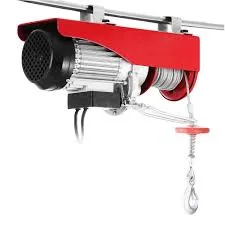


Understanding Chain Hoists A Comprehensive Guide
Chain hoists are essential tools in various industries and applications that require lifting heavy objects. These devices are designed to make lifting and lowering loads easier, safer, and more efficient. Whether used in construction, manufacturing, or warehouse operations, chain hoists are versatile and dependable devices that play a crucial role in material handling.
What is a Chain Hoist?
A chain hoist is a type of lifting equipment that employs a chain mechanism to lift heavy loads. Typically, these hoists consist of a metal frame, a lifting chain, and a hook to attach the load. The mechanism operates by pulling the chain through a series of gears, which multiplies the force applied, allowing even a single operator to lift incredibly heavy items with minimal effort.
Types of Chain Hoists
There are two primary types of chain hoists manual chain hoists and electric chain hoists.
1. Manual Chain Hoists Manual chain hoists, also known as chain blocks, are operated by hand. The user pulls on a hand chain to wind the lifting chain around a drum, lifting the load. These hoists are ideal for situations where electricity isn’t accessible or where lifting needs are intermittent. They are generally more affordable, lightweight, and portable, making them popular in small workshops and for occasional use.
2. Electric Chain Hoists Electric chain hoists are powered by an electric motor, which automatically lifts and lowers the load with the push of a button. These hoists are faster and more efficient than manual versions and are suitable for heavy-duty applications where frequent lifting is necessary. Electric hoists minimize human effort and reduce the risk of injury associated with manual lifting.
Applications of Chain Hoists
Chain hoists have a wide range of applications across various industries

- Construction Lifting heavy materials like steel beams, bricks, and other construction supplies. - Warehousing Moving bulky items or products between shelves and transport vehicles. - Manufacturing Assisting in assembly lines or moving products along production floors. - Maintenance and Repair Supporting engines, machinery, or equipment during servicing or maintenance.
Importance of Safety
While chain hoists are invaluable tools, safety is paramount when using them. Here are some essential safety tips
1. Inspect Equipment Regularly Before each use, check for any signs of wear or damage. Look for frayed chains, worn gears, and damaged hooks.
2. Use Proper Technique When using a manual chain hoist, ensure you are using your body weight correctly to avoid injury. In the case of electric hoists, adhere to your operational manual for proper use.
3. Prevent Overloading Be aware of the hoist's weight limit and never exceed it. Overloading can lead to equipment failure and serious accidents.
4. Secure Loads Properly Always ensure that loads are securely attached to the hook before lifting. A loose load can fall and cause injury or damage.
5. Training and Certification Ensure that operators are properly trained and understand how to use the equipment safely. Many jurisdictions require certification for operators of lifting equipment.
Conclusion
Chain hoists are vital tools in many industrial applications, enabling the safe and efficient handling of heavy loads. Understanding the different types, applications, and safety measures associated with chain hoists is essential for any operator or organization that uses this equipment. By adhering to safety protocols and maintaining the hoists, you can ensure a safe working environment while reaping the benefits of this indispensable lifting technology. Whether you choose a manual or electric chain hoist, being informed is the key to effective and safe operation.



